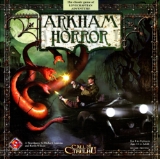
Arkham Horror
Encyclopedia
Arkham Horror is an adventure board game
designed by Richard Launius, originally published in 1987 by Chaosium
and most recently published in 2005 and revised in 2007 by Fantasy Flight Games
. In both editions, players take on the role of investigators in H. P. Lovecraft
's Massachusetts
town of Arkham
. Gates to other planes open throughout the town. If too many gates open, a powerful alien being will enter, likely destroying the town and possibly threatening the world. The investigators must avoid or fight alien creatures that enter Arkham through the gates, enter the gates themselves, survive the alien places beyond, return to Arkham, and close the gates.
. It was edited in house by Chaosium, who added such features as the Doom Track, a method to track progress toward the total failure of the players, and was published in 1987 as Arkham Horror. The game won the "Best Fantasy or Science Fiction Boardgame of 1987" award in the Origins Awards.
Arkham Horror was one of several Lovecraft-based board games submitted by Launius, with other designs from the same period including 'The Trail of the Brotherhood', 'DreamQuests', and 'Imprisoned with the Pharaohs'. Arkham Horror was the only of these games to see professional publication.
At the time Arkham Horror was one of the first cooperative board games - a game in which the players were working together to defeat the system. It was also a rare board game which did a good job of adapting roleplaying gameplay
. As a result of these two elements, it quickly became a cult classic.
The original printing of Arkham Horror soon sold out, and throughout the 1990s and the early 2000s it was one of the most-wanted out-of-print American board games. Chaosium announced reprints several times, but they never occurred.
In 2004 online game company Skotos
acquired the rights to Arkham Horror from Richard Launius, and later arranged publication with Fantasy Flight Games. The game underwent several revisions in this process. Skotos reorganized many of the elements in the game for improved cohesion and arranged for it to more carefully follow the maps of Arkham created by Chaosium and used in their own Lovecraft Country: Arkham by Night online game. Launius added several new elements, including clue tokens and some rearrangements to the decks of cards. Finally, Kevin Wilson at Fantasy Flight massively revamped the game, throwing out a roll-and-move system as well as other concepts and also expanding a lot of the gameplay. The 2005 edition shares art and other elements with Fantasy Flight Games' other Cthulhu Mythos based game: Call of Cthulhu Collectible Card Game
.
The new edition was released in July 2005 and sold out, with a second reprinting also being released in 2005.
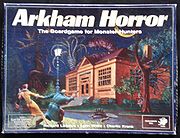
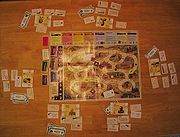
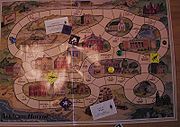
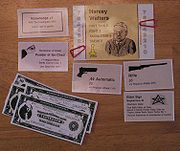 The 1987 version of Arkham Horror has relatively simple rules in comparison with the 2005 edition. Cards and tokens are illustrated with black and white drawings and silhouettes. The map of Arkham consists of a set of intertwined routes with a large number of spaces. There are several locations off the routes, such as Miskatonic University or Dark's Carnival, where a player's investigator may have encounters, or where a gate to another world may appear. The other worlds themselves are in a row at the top of the game board. Encounter events in Arkham are determined by rolling a die and consulting a table for that location.
The 1987 version of Arkham Horror has relatively simple rules in comparison with the 2005 edition. Cards and tokens are illustrated with black and white drawings and silhouettes. The map of Arkham consists of a set of intertwined routes with a large number of spaces. There are several locations off the routes, such as Miskatonic University or Dark's Carnival, where a player's investigator may have encounters, or where a gate to another world may appear. The other worlds themselves are in a row at the top of the game board. Encounter events in Arkham are determined by rolling a die and consulting a table for that location.
Investigators usually move a random number of spaces based on the roll of two six-sided dice. The investigator cards are pre-made, with four fixed attributes: Fast Talk, Fight, Knowledge, and Sneak. To successfully use an attribute, the player rolls one six-sided die to get a value equal or below the attribute's value. Paperclips are used to track two numbers that frequently change: Sanity and Strength.
The turns of the investigators are preceded by the "Mythos Phase", where a gate and monsters may appear. For each new gate that opens, the Doom Counter increases by one; the "Doom of Arkham" occurs when there are more than 13 open gates, and all players lose. Monsters move throughout the town, attacking any investigators they happen upon; seeing some monsters results in a sanity loss. In true Lovecraft fashion, if an investigator in the town loses all Sanity or Strength, they are ignored by the monsters. The collapsed investigator is transported to the Sanitarium or Hospital, as appropriate, for treatment. Such vital losses in the other worlds result in the death of the investigator, and the player must start a new one.
Victory is achieved by closing all of the gates that have opened. Closing a gate requires passing into it to another world, and taking two encounters there; upon return to Arkham, the investigator must attack the gate successfully to close it. Closing a gate reduces the Doom Counter by one.
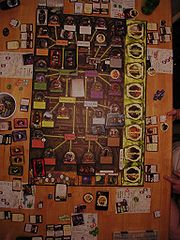
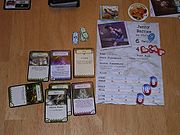 Each player selects an investigator character that is provided with the game. These characters have three pairs of statistics to represent their strengths and weaknesses, and the ability to "slide" their current focus on each scale towards either extreme or keep it relatively average. For example, Lore and Luck is one pair - if you maximize your character's Lore, you simultaneously minimize his or her Luck. Characters are further defined by a starting inventory and special abilities. Most importantly, each character have the stats of Sanity and Stamina. These respectively measure the character's mental stability and physical health (i.e. hit points). The back of each card includes a brief history for the character, in case players wish to add an element of roleplaying to the game.
Each player selects an investigator character that is provided with the game. These characters have three pairs of statistics to represent their strengths and weaknesses, and the ability to "slide" their current focus on each scale towards either extreme or keep it relatively average. For example, Lore and Luck is one pair - if you maximize your character's Lore, you simultaneously minimize his or her Luck. Characters are further defined by a starting inventory and special abilities. Most importantly, each character have the stats of Sanity and Stamina. These respectively measure the character's mental stability and physical health (i.e. hit points). The back of each card includes a brief history for the character, in case players wish to add an element of roleplaying to the game.
Each player's character is placed on the game board at the location specified on their card. They are given any items specified as well as their starting Sanity and Stamina tokens. At this time, the players should also pick which Ancient One they will be attempting to defeat. This is usually done by randomly drawing the Ancient One's card, but can also be selected intentionally if the players choose to do so.
The basic resolution mechanic is to roll a number of six-sided dice
equal to the statistic, plus any modifiers. Results of a five or a six on a die is considered a success. Most checks only require a single success, with the general exception of Sanity and Combat rolls when fighting monsters. For instance, a card may require a Lore -1 roll. If the character has a Lore stat of 4, they would roll three dice and if at least one die lands on a five or six the character has passed the roll (and may gain a benefit), otherwise he or she has failed (and may suffer a consequence).
Characters may also become Blessed, which allows them to succeed on a four or higher; or Cursed, which means they can only succeed on a roll of six. Throughout the game, characters collect Clue tokens; a Clue token can be spent to get a bonus die during a roll. There are Skill cards that can be acquired, increasing a statistic by one as well as granting an extra bonus die when you spend a Clue token on that particular type of roll.
Each turn, the players move their characters on the board and either have Encounters at a location (by drawing cards specific to that board location) or fight monsters. They may also purchase items at some locations, or take advantage of other special features. For example, characters who spend a turn at Arkham Asylum will regain a point to their sanity score, or they may spend $2 in-game to regain their maximum sanity. Either way, it takes the place of their normal Encounter card draw for that turn.
Characters who encounter monsters have the option to sneak past them or fight them. Fighting a monster first involves a Sanity check, needing only a single success but losing Sanity tokens indicated on the monster if the roll fails. After that check, the character may cast spells or use weapons to affect the combat. If the monster is not immediately destroyed or removed from the board, they then roll Fight plus any bonuses from weapons, items or spells. Some monsters only require a single success, while others may require several to destroy.
At the end of each turn, the first player draws a card from the Mythos deck. This causes a gate to another world to open, as well as releasing new monsters onto the board, causing existing monsters to move on the board and often adding a new effect to gameplay. If enough monsters appear on the board, they are recycled, and the terror level of Arkham increases, indicating that Arkham is slowly being completely overrun by monsters. If the terror level rises high enough, stores begin to close and potential allies flee, and the Ancient One will awaken even faster once Arkham becomes completely infested. Weather may make it more difficult to move through the streets or a rumor might require investigators to complete an action in a certain number of turns to prevent even worse effects from happening. After the Mythos card is resolved, play passes clockwise to the next player to start a new turn.
Certain events add tokens to the Ancient One's card, representing how close it is to awakening. Typically, when a new gate opens a token goes onto the Ancient One's card. Gates may be closed by investigators through a die roll. Alternately, a gate may be sealed by spending Clue tokens, or with an Elder Sign
item. Sealing a gate prevents another gate from opening in that location again, and using an Elder Sign removes a token from the Ancient One.
 If the Ancient One's card reaches a specified number, it awakens and investigators must immediately deal with the threat. Combat against an Ancient One varies, but typically involves making rolls to remove tokens from it, while the Ancient One lowers their stats each turn or takes certain tokens from them. Investigators who lose all of that token type are immediately devoured and removed from the game. If the Ancient One is defeated, the players win; otherwise, the game is over and they have lost.
If the Ancient One's card reaches a specified number, it awakens and investigators must immediately deal with the threat. Combat against an Ancient One varies, but typically involves making rolls to remove tokens from it, while the Ancient One lowers their stats each turn or takes certain tokens from them. Investigators who lose all of that token type are immediately devoured and removed from the game. If the Ancient One is defeated, the players win; otherwise, the game is over and they have lost.
, one of Lovecraft's iconic Old Ones.
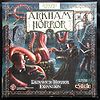 The second expansion entitled Dunwich Horror was released during Gen Con
The second expansion entitled Dunwich Horror was released during Gen Con
2006. Based on Lovecraft's short story The Dunwich Horror
, it includes a new board that is placed against the original Arkham Horror board. This new board features locations in the town of Dunwich. Investigators may visit Dunwich by travelling through the Train Station in Arkham or using certain vehicle items. In addition, the game includes new Encounter, Mythos and item cards as well as new mechanics, such as the stalking monster movement, and new Great Old Ones. When a character loses their last point of Sanity, they may take a Madness card which imposes restrictions on the character and restores their maximum Sanity, instead of being sent to Arkham Asylum. A similar Injury deck is provided for investigators who reach zero Stamina. Plus, a new monster, the Dunwich Horror itself, is provided as a special monster whose powers vary from combat to combat.
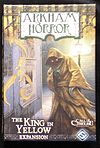 A third expansion, The King in Yellow, was confirmed in October 2006 and released in June 2007. Like Curse of the Dark Pharaoh, it is a card-only expansion, which this time focuses on a mysterious play that is being performed in Arkham. Based on the Robert W. Chambers
A third expansion, The King in Yellow, was confirmed in October 2006 and released in June 2007. Like Curse of the Dark Pharaoh, it is a card-only expansion, which this time focuses on a mysterious play that is being performed in Arkham. Based on the Robert W. Chambers
story The King in Yellow
, this expansion introduces the mechanic of the Herald — a special card that permanently alters the game rules. The first Herald is The King in Yellow himself, which causes the Doom track to increase every time the Terror track does unless you take a permanent penalty. Support for The Dark Pharaoh has since been added on the Fantasy Flight Games website as a Herald for the Curse of the Dark Pharaoh expansion. A third Herald has also been added on the Fantasy Flight Games website for the Dunwich Horror expansion.
A fourth expansion, Kingsport
Horror, was released in June 2008. It is similar to Dunwich Horror in that it is board-based rather than card-based. This expansion adds the additional locations of Kingsport, a new game element of Dimensional Rifts, and aquatic monsters that may move to any other "aquatic" location instead of following normal routes. The expansion also includes new Ancient Ones, new Investigators, new Heralds and introduces Guardians which assist the players much the way Heralds hinder them.
A fifth expansion, Black Goat of the Woods, was released at Gen Con
in August 2008. Another cards-only expansion, the set adds another Herald, a new membership similar to the Silver Twilight Lodge, a new element called Corruption, and difficulty cards that allow you to make the game optionally easier or harder. In addition, the expansion includes additional Mythos, Gate, Encounter, Spell, Skill, and Unique and Common item cards to be incorporated into the original game.
A sixth expansion, Innsmouth
Horror, was announced on the Fantasy Flight Games Website in February 2009 and released in May 2009. The third board expansion adds the town of Innsmouth as well as 16 new investigators, 8 new Ancient Ones, and two new Heralds. Also included are new personal stories cards for investigators, monsters, and encounter cards.
A seventh expansion, The Lurker at the Threshold was announced in February 2010. It was released by Fantasy Flight Games in July 2010. This is a small expansion, including a new herald sheet along with over 100 location cards, new Mythos, Gate cards, spells, etc. This expansion includes 18 Gate Markers, designed to replace original ones, and introduces new challenges for investigators trying to seal them. In addition new special Relationship cards were included, which describe how the investigator to your left is related to you and grants some benefit. Also, a new mechanic of making pacts with the Lurker itself were introduced.
An eighth expansion, Miskatonic Horror was announced in February 2011. It was released in July 2011 . The eighth expansion adds nearly 450 new cards, including new Skill, Gate, and Mythos cards. This expansion adds mostly to the other Arkham Horror expansions apart from the main game. Also, new player reference sheets as well as a new Institution variant has been added.
Adventure board game
An adventure board game is a board game in which a player plays as a unique individual character that improves through gameplay. This improvement is commonly reflected in terms of increasing character attributes, but also in receiving new abilities or equipment.Adventure board games often...
designed by Richard Launius, originally published in 1987 by Chaosium
Chaosium
Chaosium is one of the longer lived publishers of role-playing games still in existence. Founded by Greg Stafford, its first game was actually a wargame, White Bear and Red Moon, which later mutated into Dragon Pass and its sequel, Nomad Gods...
and most recently published in 2005 and revised in 2007 by Fantasy Flight Games
Fantasy Flight Games
Fantasy Flight Games is a Roseville, Minnesota-based game company that creates and publishes role-playing, board, and card games. Fantasy Flight Publishing was founded in 1995 by its CEO, Christian T. Petersen. Since the release of its first game product in 1997, the company has been doing...
. In both editions, players take on the role of investigators in H. P. Lovecraft
H. P. Lovecraft
Howard Phillips Lovecraft --often credited as H.P. Lovecraft — was an American author of horror, fantasy and science fiction, especially the subgenre known as weird fiction....
's Massachusetts
Massachusetts
The Commonwealth of Massachusetts is a state in the New England region of the northeastern United States of America. It is bordered by Rhode Island and Connecticut to the south, New York to the west, and Vermont and New Hampshire to the north; at its east lies the Atlantic Ocean. As of the 2010...
town of Arkham
Arkham
Arkham is a fictional city in Massachusetts, part of the Lovecraft Country setting created by H. P. Lovecraft and is featured in many of his stories, as well as those of other Cthulhu Mythos writers....
. Gates to other planes open throughout the town. If too many gates open, a powerful alien being will enter, likely destroying the town and possibly threatening the world. The investigators must avoid or fight alien creatures that enter Arkham through the gates, enter the gates themselves, survive the alien places beyond, return to Arkham, and close the gates.
Overview
The game board is made up of locations in Lovecraft's fictional city of Arkham during 1926. Street, building and outdoor locations are featured, as well as otherworldly locations that investigators can venture into. Players each have an investigator, represented by a character card, several attributes, and cards representing items, spells, and other things. As game play progresses, gates to these other worlds open and are represented by tokens placed on the board. Monsters from the other worlds enter through the gates and wander the city. The investigators travel through the city, avoiding or fighting the monsters, visiting city locations to acquire tools, and ultimately entering the gates. After traveling through the other world and returning, the investigator can try to close the gate. While exploring city locations or other worlds, the investigators face random challenges and benefits. As gates open, a "Doom Track" advances; if it reaches the end, a powerful horrific creature known as the Ancient One breaks through into Arkham. In the 1987 edition of the game, this ends the game in failure for the players. In the 2005 edition, this (in most cases) begins an endgame in which the players have a small chance to defeat the creature and win; otherwise they lose.History
Arkham Horror was originally submitted to Chaosium Inc. by Richard Launius as Call of Cthulhu: The Board Game, a new strategic game based on their Call of Cthulhu role-playing gameCall of Cthulhu (role-playing game)
Call of Cthulhu is a horror fiction role-playing game based on H. P. Lovecraft's story of the same name and the associated Cthulhu Mythos.The game, often abbreviated as CoC, is published by Chaosium.-Setting:...
. It was edited in house by Chaosium, who added such features as the Doom Track, a method to track progress toward the total failure of the players, and was published in 1987 as Arkham Horror. The game won the "Best Fantasy or Science Fiction Boardgame of 1987" award in the Origins Awards.
Arkham Horror was one of several Lovecraft-based board games submitted by Launius, with other designs from the same period including 'The Trail of the Brotherhood', 'DreamQuests', and 'Imprisoned with the Pharaohs'. Arkham Horror was the only of these games to see professional publication.
At the time Arkham Horror was one of the first cooperative board games - a game in which the players were working together to defeat the system. It was also a rare board game which did a good job of adapting roleplaying gameplay
Gameplay
Gameplay is the specific way in which players interact with a game, and in particular with video games. Gameplay is the pattern defined through the game rules, connection between player and the game, challenges and overcoming them, plot and player's connection with it...
. As a result of these two elements, it quickly became a cult classic.
The original printing of Arkham Horror soon sold out, and throughout the 1990s and the early 2000s it was one of the most-wanted out-of-print American board games. Chaosium announced reprints several times, but they never occurred.
In 2004 online game company Skotos
Skotos
Skotos, sometimes known as Skotos Tech, is an online game company that was founded in 1999 and released its first game, Castle Marrach, in September 2000. Its primary focus is prose online RPGs , though it currently offers a total of 15 different games...
acquired the rights to Arkham Horror from Richard Launius, and later arranged publication with Fantasy Flight Games. The game underwent several revisions in this process. Skotos reorganized many of the elements in the game for improved cohesion and arranged for it to more carefully follow the maps of Arkham created by Chaosium and used in their own Lovecraft Country: Arkham by Night online game. Launius added several new elements, including clue tokens and some rearrangements to the decks of cards. Finally, Kevin Wilson at Fantasy Flight massively revamped the game, throwing out a roll-and-move system as well as other concepts and also expanding a lot of the gameplay. The 2005 edition shares art and other elements with Fantasy Flight Games' other Cthulhu Mythos based game: Call of Cthulhu Collectible Card Game
Call of Cthulhu Collectible Card Game
The Call of Cthulhu Collectible Card Game or Call of Cthulhu Living Card Game is a collectible card game marketed by Fantasy Flight Games. It is based on the fiction of the Cthulhu Mythos, primarily the writings of H. P. Lovecraft and Chaosium's Call of Cthulhu role-playing game...
.
The new edition was released in July 2005 and sold out, with a second reprinting also being released in 2005.
1987 edition




Investigators usually move a random number of spaces based on the roll of two six-sided dice. The investigator cards are pre-made, with four fixed attributes: Fast Talk, Fight, Knowledge, and Sneak. To successfully use an attribute, the player rolls one six-sided die to get a value equal or below the attribute's value. Paperclips are used to track two numbers that frequently change: Sanity and Strength.
The turns of the investigators are preceded by the "Mythos Phase", where a gate and monsters may appear. For each new gate that opens, the Doom Counter increases by one; the "Doom of Arkham" occurs when there are more than 13 open gates, and all players lose. Monsters move throughout the town, attacking any investigators they happen upon; seeing some monsters results in a sanity loss. In true Lovecraft fashion, if an investigator in the town loses all Sanity or Strength, they are ignored by the monsters. The collapsed investigator is transported to the Sanitarium or Hospital, as appropriate, for treatment. Such vital losses in the other worlds result in the death of the investigator, and the player must start a new one.
Victory is achieved by closing all of the gates that have opened. Closing a gate requires passing into it to another world, and taking two encounters there; upon return to Arkham, the investigator must attack the gate successfully to close it. Closing a gate reduces the Doom Counter by one.
Gameplay


Each player's character is placed on the game board at the location specified on their card. They are given any items specified as well as their starting Sanity and Stamina tokens. At this time, the players should also pick which Ancient One they will be attempting to defeat. This is usually done by randomly drawing the Ancient One's card, but can also be selected intentionally if the players choose to do so.
The basic resolution mechanic is to roll a number of six-sided dice
Dice
A die is a small throwable object with multiple resting positions, used for generating random numbers...
equal to the statistic, plus any modifiers. Results of a five or a six on a die is considered a success. Most checks only require a single success, with the general exception of Sanity and Combat rolls when fighting monsters. For instance, a card may require a Lore -1 roll. If the character has a Lore stat of 4, they would roll three dice and if at least one die lands on a five or six the character has passed the roll (and may gain a benefit), otherwise he or she has failed (and may suffer a consequence).
Characters may also become Blessed, which allows them to succeed on a four or higher; or Cursed, which means they can only succeed on a roll of six. Throughout the game, characters collect Clue tokens; a Clue token can be spent to get a bonus die during a roll. There are Skill cards that can be acquired, increasing a statistic by one as well as granting an extra bonus die when you spend a Clue token on that particular type of roll.
Each turn, the players move their characters on the board and either have Encounters at a location (by drawing cards specific to that board location) or fight monsters. They may also purchase items at some locations, or take advantage of other special features. For example, characters who spend a turn at Arkham Asylum will regain a point to their sanity score, or they may spend $2 in-game to regain their maximum sanity. Either way, it takes the place of their normal Encounter card draw for that turn.
Characters who encounter monsters have the option to sneak past them or fight them. Fighting a monster first involves a Sanity check, needing only a single success but losing Sanity tokens indicated on the monster if the roll fails. After that check, the character may cast spells or use weapons to affect the combat. If the monster is not immediately destroyed or removed from the board, they then roll Fight plus any bonuses from weapons, items or spells. Some monsters only require a single success, while others may require several to destroy.
At the end of each turn, the first player draws a card from the Mythos deck. This causes a gate to another world to open, as well as releasing new monsters onto the board, causing existing monsters to move on the board and often adding a new effect to gameplay. If enough monsters appear on the board, they are recycled, and the terror level of Arkham increases, indicating that Arkham is slowly being completely overrun by monsters. If the terror level rises high enough, stores begin to close and potential allies flee, and the Ancient One will awaken even faster once Arkham becomes completely infested. Weather may make it more difficult to move through the streets or a rumor might require investigators to complete an action in a certain number of turns to prevent even worse effects from happening. After the Mythos card is resolved, play passes clockwise to the next player to start a new turn.
Certain events add tokens to the Ancient One's card, representing how close it is to awakening. Typically, when a new gate opens a token goes onto the Ancient One's card. Gates may be closed by investigators through a die roll. Alternately, a gate may be sealed by spending Clue tokens, or with an Elder Sign
Elder Sign
The Elder Sign is an icon in the Cthulhu Mythos, first mentioned in H. P. Lovecraft's The Dream Quest of Unknown Kadath, written in 1926.-Description:...
item. Sealing a gate prevents another gate from opening in that location again, and using an Elder Sign removes a token from the Ancient One.

Expansions
An expansion entitled Curse of the Dark Pharaoh was released in June, 2006, with a revised version released in 2011. This expansion added many new cards to the game, including items and encounters. The theme was that a travelling museum exhibit from Egypt has arrived in Arkham, bringing with it accursed artifacts and strange happenings. Heavy emphasis is placed on NyarlathotepNyarlathotep
Nyarlathotep, also known as the Crawling Chaos, is a malign deity in the Cthulhu Mythos fictional universe created by H. P. Lovecraft. First appearing in Lovecraft's 1920 prose poem of the same name, he was later mentioned in other works by Lovecraft and by other writers and in the tabletop...
, one of Lovecraft's iconic Old Ones.

Gen Con
Gen Con is one of the largest and most prominent annual gaming conventions in North America. It features traditional pen-and-paper, board, and card-style games, including role-playing games, miniatures wargames, board games, live action role-playing games, collectible card games, non-collectible...
2006. Based on Lovecraft's short story The Dunwich Horror
The Dunwich Horror
"The Dunwich Horror" is a short story by H. P. Lovecraft. Written in 1928, it was first published in the April 1929 issue of Weird Tales . It takes place in Dunwich, a fictional town in Massachusetts...
, it includes a new board that is placed against the original Arkham Horror board. This new board features locations in the town of Dunwich. Investigators may visit Dunwich by travelling through the Train Station in Arkham or using certain vehicle items. In addition, the game includes new Encounter, Mythos and item cards as well as new mechanics, such as the stalking monster movement, and new Great Old Ones. When a character loses their last point of Sanity, they may take a Madness card which imposes restrictions on the character and restores their maximum Sanity, instead of being sent to Arkham Asylum. A similar Injury deck is provided for investigators who reach zero Stamina. Plus, a new monster, the Dunwich Horror itself, is provided as a special monster whose powers vary from combat to combat.

Robert W. Chambers
Robert William Chambers was an American artist and writer.-Biography:He was born in Brooklyn, New York, to William P. Chambers , a famous lawyer, and Caroline Chambers , a direct descendant of Roger Williams, the founder of Providence, Rhode Island...
story The King in Yellow
The King in Yellow
The King in Yellow is a collection of short stories written by Robert W. Chambers and published in 1895. The stories could be categorized as early horror fiction or Victorian Gothic fiction, but the work also touches on mythology, fantasy, mystery, science fiction and romance...
, this expansion introduces the mechanic of the Herald — a special card that permanently alters the game rules. The first Herald is The King in Yellow himself, which causes the Doom track to increase every time the Terror track does unless you take a permanent penalty. Support for The Dark Pharaoh has since been added on the Fantasy Flight Games website as a Herald for the Curse of the Dark Pharaoh expansion. A third Herald has also been added on the Fantasy Flight Games website for the Dunwich Horror expansion.
A fourth expansion, Kingsport
Kingsport (Lovecraft)
Kingsport is a fictional town in the writings of H. P. Lovecraft. The town first appeared in Lovecraft's short story "The Terrible Old Man"...
Horror, was released in June 2008. It is similar to Dunwich Horror in that it is board-based rather than card-based. This expansion adds the additional locations of Kingsport, a new game element of Dimensional Rifts, and aquatic monsters that may move to any other "aquatic" location instead of following normal routes. The expansion also includes new Ancient Ones, new Investigators, new Heralds and introduces Guardians which assist the players much the way Heralds hinder them.
A fifth expansion, Black Goat of the Woods, was released at Gen Con
Gen Con
Gen Con is one of the largest and most prominent annual gaming conventions in North America. It features traditional pen-and-paper, board, and card-style games, including role-playing games, miniatures wargames, board games, live action role-playing games, collectible card games, non-collectible...
in August 2008. Another cards-only expansion, the set adds another Herald, a new membership similar to the Silver Twilight Lodge, a new element called Corruption, and difficulty cards that allow you to make the game optionally easier or harder. In addition, the expansion includes additional Mythos, Gate, Encounter, Spell, Skill, and Unique and Common item cards to be incorporated into the original game.
A sixth expansion, Innsmouth
Innsmouth
Innsmouth is a fictional town in the writings of H. P. Lovecraft, part of the Lovecraft Country setting of the Cthulhu Mythos.Lovecraft first used the name "Innsmouth" in his 1920 short story "Celephaïs" , where it refers to a fictional town in New England...
Horror, was announced on the Fantasy Flight Games Website in February 2009 and released in May 2009. The third board expansion adds the town of Innsmouth as well as 16 new investigators, 8 new Ancient Ones, and two new Heralds. Also included are new personal stories cards for investigators, monsters, and encounter cards.
A seventh expansion, The Lurker at the Threshold was announced in February 2010. It was released by Fantasy Flight Games in July 2010. This is a small expansion, including a new herald sheet along with over 100 location cards, new Mythos, Gate cards, spells, etc. This expansion includes 18 Gate Markers, designed to replace original ones, and introduces new challenges for investigators trying to seal them. In addition new special Relationship cards were included, which describe how the investigator to your left is related to you and grants some benefit. Also, a new mechanic of making pacts with the Lurker itself were introduced.
An eighth expansion, Miskatonic Horror was announced in February 2011. It was released in July 2011 . The eighth expansion adds nearly 450 new cards, including new Skill, Gate, and Mythos cards. This expansion adds mostly to the other Arkham Horror expansions apart from the main game. Also, new player reference sheets as well as a new Institution variant has been added.
Reception
Arkham Horror is generally a well-received game, but noted by most players to be challenging to learn the first few times one plays, and requires a larger amount of time and play space than most traditional board games.External links
- Fantasy Flight's Arkham Horror webpage
- Arkham Horror Wiki

